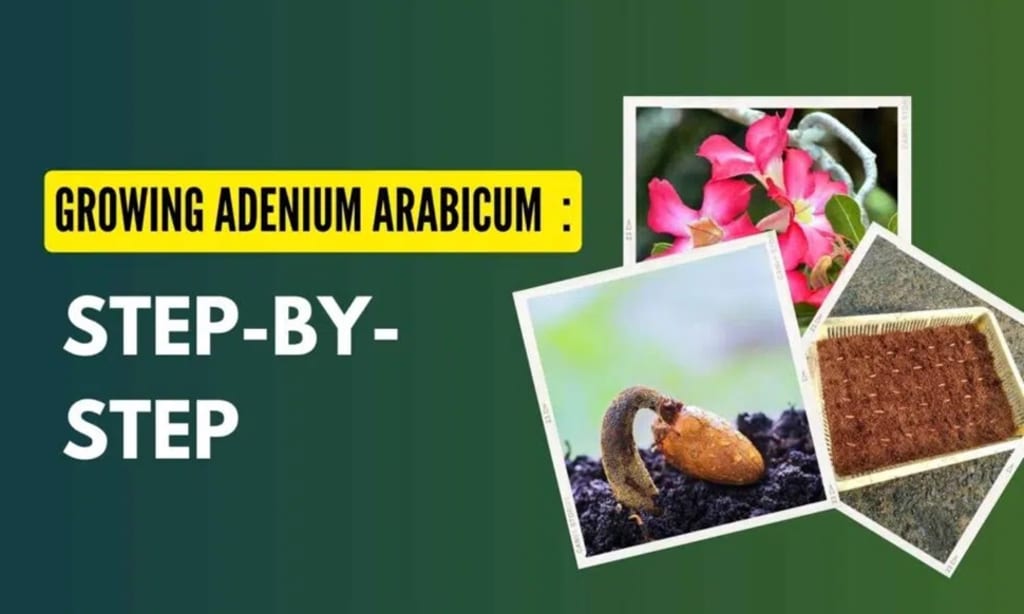Growing Adenium Arabicum Seeds : Step-by-Step
Growing Adenium Arabicum Seeds : Step-by-Step

Title: A Gardener's Guide to Growing Adenium Arabicum Seeds: Step-by-Step
Adenium Arabicum, commonly known as Desert Rose, is a stunning succulent plant native to arid regions of Africa and the Middle East. Renowned for its striking flowers and unique bonsai-like appearance, cultivating Adenium from seeds can be a rewarding experience for any gardening enthusiast. If you're eager to start your journey into growing Adenium Arabicum from seeds, follow these step-by-step instructions to ensure success.
1. **Seed Selection:**
Before starting your Adenium Arabicum journey, choose high-quality seeds from a reputable supplier or source. Fresh seeds generally have a higher germination rate, increasing your chances of success. Opt for seeds that are plump, firm, and free from any signs of damage or decay.
2. **Preparation of Growing Medium:**
Adenium Arabicum thrives in well-draining soil to prevent waterlogged conditions, which can lead to root rot. Prepare a well-draining potting mix using a combination of perlite, coarse sand, and potting soil. This mixture provides excellent aeration and drainage necessary for healthy seedling development.
3. **Seed Planting:**
Fill small seedling trays or pots with the prepared growing medium. Moisten the soil slightly before planting to ensure it is evenly moist but not waterlogged. Plant the Adenium Arabicum seeds approximately 1/4 to 1/2 inch deep in the soil. Space the seeds evenly to allow adequate room for growth.
4. **Optimal Conditions for Germination:**
Place the seedling trays or pots in a warm, well-lit location with indirect sunlight. Adenium Arabicum seeds require temperatures between 70°F to 90°F (21°C to 32°C) for successful germination. Ensure consistent moisture levels by misting the soil lightly whenever it begins to dry out, but avoid overwatering, as it can lead to fungal issues.
5. **Patience and Monitoring:**
Germination of Adenium Arabicum seeds can take anywhere from one to four weeks, depending on various factors such as temperature and seed quality. During this period, regularly monitor the soil moisture levels and provide adequate ventilation to prevent damping off or fungal diseases.
6. **Seedling Care:**
Once the seeds have germinated, delicate seedlings will emerge from the soil. Maintain consistent moisture levels by watering the seedlings when the top layer of soil feels dry to the touch. Avoid overhead watering to prevent water from pooling around the delicate stems.
7. **Transplanting Seedlings:**
When the seedlings have developed several sets of true leaves and are sturdy enough to handle, they can be transplanted into individual pots. Use pots with drainage holes to ensure excess water can escape easily. Gently loosen the soil around the seedlings and carefully lift them, ensuring you disturb the roots as little as possible.
8. **Optimal Growing Conditions:**
Provide your Adenium Arabicum seedlings with optimal growing conditions to encourage healthy growth and development. Place them in a sunny location where they can receive at least six to eight hours of sunlight daily. Maintain temperatures above 60°F (15°C) to prevent cold stress.
9. **Watering and Fertilization:**
Water your Adenium Arabicum plants thoroughly whenever the soil feels dry to the touch, allowing excess water to drain away completely. During the growing season, fertilize your plants with a balanced liquid fertilizer diluted to half strength every two to four weeks to promote robust growth and vibrant blooms.
10. **Pruning and Training:**
As your Adenium Arabicum plants mature, you can prune them to maintain their desired shape and size. Regularly remove any dead or diseased foliage to prevent the spread of pests and diseases. Additionally, you can train the branches to create interesting bonsai-like forms, adding to the aesthetic appeal of your plants.
11. **Pest and Disease Management:**
Keep a close eye on your Adenium Arabicum plants for any signs of pest infestations or diseases. Common pests include aphids, spider mites, and mealybugs, which can be treated with insecticidal soap or neem oil. Ensure good air circulation around your plants to discourage fungal diseases such as powdery mildew.
12. **Enjoying the Blooms:**
With proper care and attention, your Adenium Arabicum plants will reward you with spectacular blooms in various colors, including shades of pink, red, and white. Take the time to appreciate the beauty of these unique flowers and the satisfaction of growing them from seeds.
Growing Adenium Arabicum from seeds requires patience, diligence, and a little bit of know-how, but the rewards are well worth the effort. Follow these step-by-step instructions, and you'll be well on your way to cultivating healthy, vibrant Adenium plants that will brighten up your home or garden for years to come.
About the Creator
Kavya Organic Garden
Passionate about home gardening, plant care, growth, and maintenance. Join me on this exciting journey of organic practices and sustainable gardening! 🌱






Comments
Kavya Organic Garden is not accepting comments at the moment
Want to show your support? Send them a one-off tip.